The AMD Radeon R9 290X Review
by Ryan Smith on October 24, 2013 12:01 AM EST- Posted in
- GPUs
- AMD
- Radeon
- Hawaii
- Radeon 200
Hawaii: Tahiti Refined
Thus far when we’ve been discussing Hawaii, it’s typically been in comparison to Tahiti, and there’s good reason for that. Besides the obvious parallel of being AMD’s new flagship GPU, finally succeeding Tahiti after just short of 2 years, in terms of design Hawaii looks and acts a lot like an improved Tahiti. The underlying architecture is still Graphics Core Next, and a lot of the compute functionality that gave Tahiti its broad applicability to graphics and compute alike is equally present in Hawaii, so in many ways Hawaii looks and behaves like a bigger Tahiti. But as we’ve seen over the years with these second wind parts, there’s are a lot of finer details involved taking an existing architecture and building it bigger, never mind the subtle feature additions that come with Hawaii.
The biggest addition with Hawaii is of course the increased number of functional units. 2 years in and against GPUs like NVIDIA’s GK110, AMD has a clear need to produce a larger, more powerful GPU if they wish to stay competitive with NVIDIA at the high end while also delivering newer, faster products for their regular customers. In doing so there’s a need to identify bottlenecks in the existing design (Tahiti) to figure out what changes will pay off the most for their die size and power consumption cost, and conversely what changes would have little payoff. The end result is that we’re seeing AMD significantly scale up some of the smaller areas of the chip, while taking a more nuanced approach on scaling up the larger areas.
But before we get too deep here, we want to quickly point out that with Hawaii AMD is making a significant change to how they’re logically representing the architecture in public, which although is striking does not mean the underlying low-level organization is nearly as different as the high-level changes would imply. At a high level the biggest change here is that AMD is now segmenting their hardware into “shader engines”. Conceptually the idea is similar to NVIDIA’s SMXes, with each Shader Engine (SE) representing a collection of hardware including shaders/CUs, geometry processors, rasterizers, and L1 cache. Furthermore ROPs are also being worked into the Shader Engine model, with each SE taking on a fraction of the ROPs for the purposes of high level overviews. What remains outside of the SEs is the command processor and ACEs, the L2 cache and memory controllers, and then the various dedicated, non-duplicated functionality such as video decoders, display controllers, DMA controllers, and the PCIe interface.
Moving forward, AMD designs are going to scale up and down both with respect to the number of SEs and in the number of CUs in each SE. This distinction is important because unlike NVIDIA’s SMX model, where the company can only scale down hardware by cutting whole SMXes, AMD can technically maintain up to 4 SEs while scaling down the number of CUs within each SE. So despite what the SE model implies, AMD’s scaling abilities are status quo for GCN in as much as they can continue to scale down for lower tier parts without sacrificing geometry or ROP performance. In reality of course the physical layout of Hawaii and other GPUs will deviate by even less, as the ROPs are still going to be tied into the memory controllers, the geometry processors are still closely integrated with the command processor, etc. Still, as a high level model it’s likely a better fit for how the underlying hardware really works, as it provides a more intuitive view on how the number of geometry processors, rasterizers, and ROPs are closedly related, or how the individual CUs are lumped together into CU arrays.
With that in mind, we’ll start or low level overview with a look at both the front end and the back end of Hawaii. Of all the aspects of the GPU AMD has scaled up compared to Hawaii, it’s at the front end and the back end that we’ll find the biggest changes due to the fact that AMD has doubled the number of functional units in most of the elements that reside here.
At the very front, in conjunction with the ACE improvements inherient to GCN 1.1, AMD has scaled up the number of ACEs from 2 in Tahiti to 8 in Hawaii. With each ACE now containing 8 work queues this brings the total number of work queues to 64. Unlike most of the other changes we’ll be going over today, the ACE increase has limited applicability for gaming, and while AMD isn’t talking about non-Radeon Hawaii products at this time, given what we know about GCN 1.1 there’s a clear applicability not only towards HSA, but also to more traditional GPU compute setups such as the FirePro S series. For GPU compute the additional ACEs and queues will help improve AMD’s real world compute performance by improving the utilization of the CUs, while the DMA engine improvements that come with the increased number of ACEs will help keep the CUs fed with data from the CPU and other GPUs.
Moving on, there are a number of back end and front end changes AMD has made to improve rendering performance, and the increased number of geometry processors is at the forefront of this. With Hawaii AMD has doubled the number of geometry engines from 2 to 4, and more closely coupling those with the existing 4 rasterizer setup they inherit. The increase in geometry processors comes at an appropriate time for the company as the last time the number of geometry processors was increased was with the 6900 series in 2010, when the company moved to 2 such processors. One of the side effects of the new consoles coming out this year is that cross-platform games will be able to use a much larger number of primitives than before – especially with the uniform addition of D3D11-style tessellation – so there’s a clear need to ramp up geometry performance to keep up with where games are expected to go.
Further coupled with this are more generalized improvements designed to improve geometry efficiency overall. Alongside the additional geometry processors AMD has also improved both on-chip and off-chip data flows, with off-chip buffering being improved to further improve AMD’s tessellation performance, while the Local Data Store can now be tapped by geometry shaders to reduce the need to go off-chip at all. More directly applicable is that the inter-stage storage (parameter and position caches) used by the geometry processors has also been increased in order to keep up with the overall increase in the number of processors.
On a side note, with every architectural revision/launch we try to get AMD’s engineers to give us an idea of what aspects they’re most proud of, and while they typically downplay the question (it’s a team effort, after all) for Hawaii the geometry processor changes have been a recurring theme of something where the engineering team is particularly proud of its work. As it turns out adding geometry processors is actually a quite a bit harder than it sounds, as the additional processors bring with it the need to balance geometry workloads across the processor cluster. When splitting up the geometry workload there are dependency issues that must be addressed, and to maximize efficiency there are load balancing/partitioning matters that must be taken into account as there’s no guarantee geometry is evenly distributed over the entire viewport. Consequently AMD’s engineers are quite happy with how this turned out due to the effort involved.
Meanwhile at the other end of the rendering pipeline we have AMD’s back end changes, which have been made in concert with the changes to the front end. The big change here is that for the first time since the 5870 (Cypress) back in 2009, AMD has increased the number of ROPs, going from 32 on Tahiti/Pitcairn to 64 on Hawaii. As ROPs are primarily tasked with jobs that are resolution dependent such as final pixel resolution and depth testing, the workload placed on ROPs has increased much more slowly over the years than the workload placed on shaders or even geometry processors. Similarly, for that reason scaling up the ROPs alone typically doesn’t have a big impact on rendering performance, hence ROP upgrades have come far more sparingly.
With Hawaii the increase in the number of ROPs comes down to a few different factors. To a large extent it’s merely a matter of “it’s time”, where the performance increases finally justify the die space increases. But AMD’s focus on 4K resolution workloads also plays a significant part, as 4K represents a significant increase in the ROP workload, and hence the need for more ROPs to pick up the work. Consequently while we can’t easily compare ROP performance across vendors, increasing the number of ROPs is one of the ways AMD will extend their high resolution performance advantage over NVIDIA, by being sure they have plenty of capacity to chew through 4K scenes.
Working in conjunction with the ROPs of course is the L2 cache, forming the second member of the ROP/L2/MC triumvirate, and like the number of ROPs this is being increased. L2 cache is more closely tied to the memory controllers than the ROPs, so while Tahiti had 32 ROPs and 768KB of L2 paired with 6 memory controllers, Hawaii gets double the ROPs but a smaller 33% increase in the L2 cache in accordance with the 33% increase in memory controllers. The end result is that Hawaii packs a full 1MB of L2 cache, and that the total bandwidth available out of the L2 cache has also been increased by 33% to a full 1TB. The L2 cache plays a role in every aspect of rendering, and as the primary backstop for the ROPs and secondary backstop for the CUs it’s critical to avoiding relatively expensive off-chip memory operations.
Lastly we have the final member of the ROP/L2/MC triumvirate, which is the memory interface. Tahiti for all of its strengths and weaknesses possesses a very large memory interface (as a percentage of die space), which has helped it reach 6GHz+ memory speeds on a 384-bit memory bus at the cost of die size. As there’s a generally proportional relationship between memory interface size and memory speeds, AMD has made the interesting move of going the opposite direction for Tahiti. Rather than scale up a 384-bit memory controller even more, they opted to scale down an even larger 512-bit memory controller with impressive results.
The result of AMD’s memory interface changes is that between the die space savings from the lower speed controllers coupled with a number of smaller tweaks to improve density, AMD has been able to implement the larger 512-bit memory interface while still reducing the size of the memory interface by 20% as compared to Tahiti. Furthermore these space savings still allow for a meaningful increase in memory bandwidth despite the lower memory clockspeeds, with AMD being able to increase their memory bandwidth by over 10% (as compared to 280X), from 288GB/sec to 320GB/sec. The end result is a very neat and clean (and impressive) improvement in AMD’s memory controllers, with AMD reducing their interface size and increasing their memory bandwidth at the same time. The 512-bit memory bus does have some externalities to it – specifically increased PCB costs and requiring more GDDR5 memory modules than Tahiti (16 vs. 12) – but these are ultimately countered by the die space savings that AMD is realizing from the smaller memory interface.
Meanwhile compared to AMD’s front end and back end changes, the Hawaii’s CU changes are much more straightforward. Besides optimizing the CUs for die size and giving them the appropriate GCN 1.1 functionality, very little has changed here. The end result is a simple increase in the number of CUs, going from 32 on Tahiti to 44 on Hawaii, with AMD continuing to distribute them evenly over the 4 Shader Engines. Shading/texturing remains the primary bottleneck for most games today, so while the CU increase is straightforward the performance implications are not to be ignored. Much of AMD’s 30% performance increase comes from this 38% increase in CUs. GCN was after all designed from the start to scale up well in this respect, so with Hawaii AMD is executing on those plans.
Moving on, having completed our look at the design of Hawaii, let’s discuss the die size of Hawaii a bit. Unlike NVIDIA, AMD doesn’t traditionally go above 400mm2 dies, and for good reason. NVIDIA holds the lion’s share of the high end, high margin workstation market, and while AMD market share has been slowly increasing from the historic lows of a couple of years ago it’s still well behind NVIDIA’s. Consequently AMD doesn’t have that high margin market to help bootstrap the production of large GPUs, requiring that they stay smaller to stay within their means.
With Hawaii AMD still isn’t entering the big die race that defines NVIDIA’s flagship GPUs, but AMD is going larger than ever before. At 438mm2 Hawaii is AMD’s biggest GPU yet, and despite AMD’s improvements in area efficiency Hawaii is still 73mm2 (20%) larger than Tahiti. The fact that AMD is able to improve their gaming performance by 30% over Tahiti means that this is a very good tradeoff to make, it just means that AMD is treading new ground in doing so.
Similarly, at 6.2 billion transistors Hawaii is AMD’s largest GPU yet by transistor count, outpacing the 4.31B Tahiti by 1.89B transistors, an increase of 44%. Now transistor counts alone don’t mean much, but the fact that AMD was able to increase their transistor density by this much is a significant accomplishment for the company.
Meanwhile on a historical basis it’s worth pointing out that while AMD’s “small die” strategy effectively died with Cayman in 2010, this marks the first time since R600 that AMD has dared to go this big. R600, AMD’s previously largest GPU, ended up being rather ill-fated, which in turn spurred on the small die strategy that defined the R700 and Evergreen GPU families. Hawaii won’t be a repeat of R600 – in particular AMD isn’t going to be repeating the unfortunate circumstance of building a large GPU against a new architecture and a new manufacturing node all at the same time – so they are certainly on far more solid ground this time. Ultimately the success of Hawaii will be based on sales and profit margins as always, but based on the performance we’re seeing and the state of AMD’s market, AMD shouldn’t have any trouble justifying a 400mm2 GPU at this point. This is yet another benefit of being a second wind product: AMD gets to build their large GPU against a mature manufacturing process, as opposed to the immature process that Tahiti had to work with.


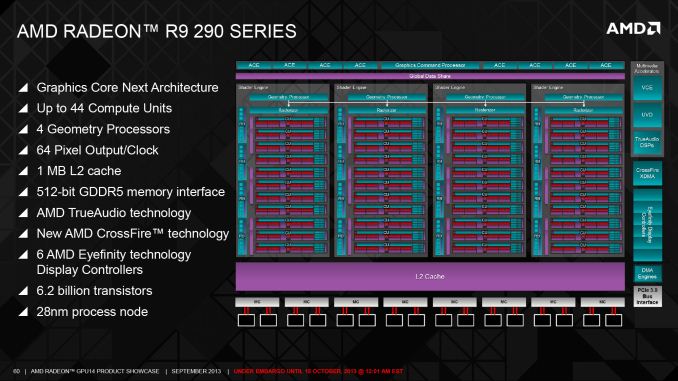
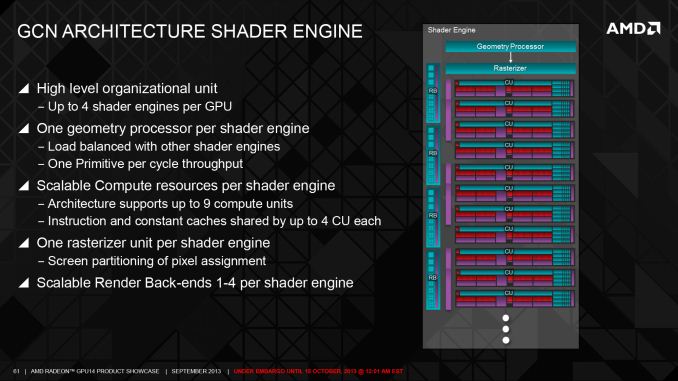

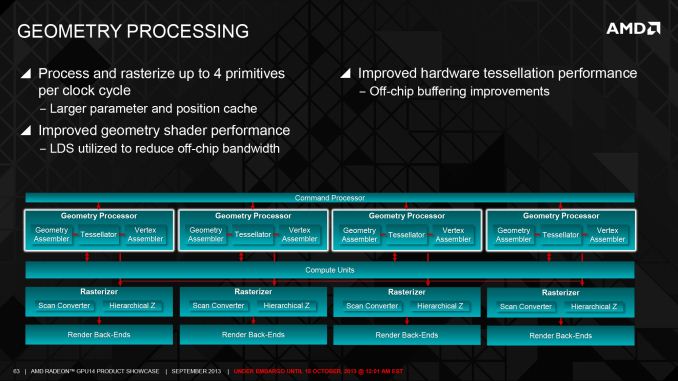
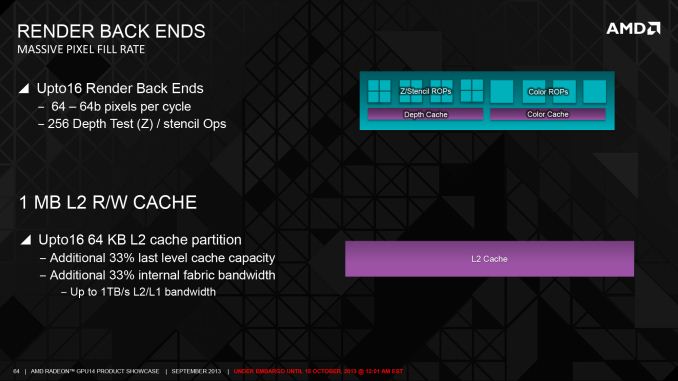
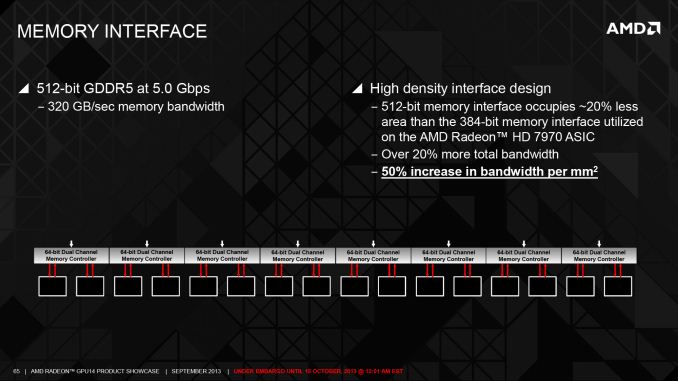

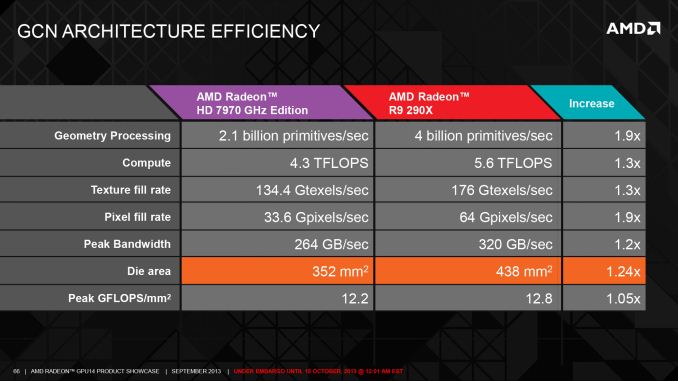








396 Comments
View All Comments
TheJian - Friday, October 25, 2013 - link
LOL. Tell that to both their bottom lines. I see AMD making nothing while NV profits. People who bought titan got a $2500 Tesla for $1000. You don't buy a titan just to game (pretty dumb if you did) as it's for pro apps too (the compute part of the deal). It's a steal for gamers who make money on the card too. Saving $1500 is a great deal. So since you're hating on NV pricing, how do you feel about the 7990 at $1000. Nice to leave that out of your comment fanboy ;) Will AMD now reap what they sow and have to deal with all the angry people who bought those? ROFL. Is the 1K business model unsustainable for AMD too? Even the 6990 came in at $700 a ways back. Dual or single chip the $1000 price is alive and well from either side for those who want it.I'd bet money a titan ultra will be $1000 again shortly if they even bother as it's not a pure gamer card but much more already. If you fire up pro apps with Cuda you'll smoke that 290x daily (which covers just about all pro apps). Let me know when AMD makes money in a quarter that NVDA loses money. Then you can say NV pricing is biting them in the A$$. Until then, your comment is ridiculous. Don't forget even as ryan points out in this article (and he don't love NV...LOL), AMD still has driver problems (and has for ages) but he believes in AMD much like fools do in Obama still...LOL. For me, even as an 5850 owner, they have to PROVE themselves before I ponder another card from them at 20nm. The 290x is hot, noisy and uses far more watts and currently isn't coming with 3 AAA games either. NV isn't shaking in their boots. I'll be shocked if 780TI isn't $600 or above as it should match Titan which 290x doesn't do even with the heat, noise and watts.
And you're correct no OC room. Nobody has hit above 1125.
If NV was greedy, wouldn't they be making MORE money than in 2007? They haven't cracked 850mil in 5 years. Meanwhile, AMD's pricing which you seem to love, has cause their entire business to basically fail (no land, no fabs, gave up cpu race, 8 months to catch up with a hot noisy chip etc). They have lost over $6B in the last 10yrs. AMD has idiots managing their company and they are destroying what used to be a GREAT company with GREAT products. They should have priced this card $100 higher and all other cards rebadged should be $50 higher. They might make some actual money then every quarter right? Single digit margins on console chips (probably until 20nm shrink) won't get you rich either. Who made that deal? FIRE THAT GUY. That margin is why NV said it wasn't worth it.
chizow - Saturday, October 26, 2013 - link
AMD's non-profitability goes far beyond their GPU business, it's more due to their CPU business. People who got Titan didn't get a Tesla for $1000, they got a Tesla without ECC. Compute apps without ECC would be like second-guessing every result because you're unsure whether a value was stored/retrieved from memory correctly. Regard to 7990 pricing, you can surely look it up before pulling the fanboy card, just as you can look up my comments on 7970 launch pricing. And yes, AMD will absolutely have to deal with that backlash giving that card dropped even more precipitously than even Titan, going from $1K to $600 in only 4-5 months.I don't think Nvidia will make the same mistake with a Titan Ultra at $1K. I also don't think Nvidia fans who only bought Titan for gaming will fall for the same mistake 2x. If Maxwell comes out and Nvidia holds out on the big ASIC, I doubt anyone disinterested in compute will fall for the same trick if Nvidia launches a Titan 2 at $1K using a compute gimmick to justify the price. They will just point to Titan and say "wait 3 months and they'll release something that's 95% of it's performance at 65% of it's price". As they say, Fool me once, shame on you, fool me twice, shame on me.
And no, greed and profit don't go hand in hand. In 2007-2008, Nvidia posted record profits and revenue for multiple consecutive quarters as you stated on the back of a cheap $230-$270 8800GT. With Titan, they reversed course by setting record margins, but on reduced revenue and profits. They basically covet Intel's huge profit margins, but they clearly lack the revenue to grow their bottomline. Selling $1K GPUs certainly isn't going to get them there any faster.
FragKrag - Thursday, October 24, 2013 - link
great performance, but I'll wait until I see some better thermals/noise from aftermarket coolers :pShark321 - Thursday, October 24, 2013 - link
As with the Titan in the beginning, no alternate coolers will be available for the time being (according to computerbase). This means even if the price is great, you will be stuck with a very noisy and hot card. 780Ti will outperform the 290x in 3 weeks. It remains to bee seen how it will be priced (I guess $599).The Von Matrices - Thursday, October 24, 2013 - link
This is the next GTX 480 or HD 2900 XT. It provides great performance for the price, that is if you can put up with the heat and noise.KaosFaction - Thursday, October 24, 2013 - link
Work in Progress!!! Whhhhaaaattttt I want answers now!!masterpine - Thursday, October 24, 2013 - link
Good to see something from AMD challenging the GK110's, I still find it fairly remarkable that in the fast moving world of GPU's it's taken 12 months for AMD to build something to compete. Hopefully this puts a swift end to the above $600 prices in the single GPU high end.More than a little concerned at the 95C target temp of these things. 80C is toasty enough already for the GTX780, actually had to point a small fan at the DVI cables coming out the back of my 780 SLI surround setup because the heat coming out the back of them was causing dramas. Not sure i could cope with the noise of a 290X either.
Anyhow, this is great for consumers. Hope to see some aftermarket coolers reign these things in a bit. If the end result is both AMD and Nvidia playing hard-ball at the $500 mark in a few weeks time, we all win.
valkyrie743 - Thursday, October 24, 2013 - link
HOLY TEMPS BATMAN. its the new gtx 480 in the temp's departmentkallogan - Thursday, October 24, 2013 - link
No overclocking headroom with stock cooler. That's for sure.FuriousPop - Thursday, October 24, 2013 - link
can we please see 2x in CF mode with eyefinity!? or am i asking for too much?also, Nvidia will always be better for those of you in the 30% department of having only max 1080p. for the rest of us in 1440p and 1600p and beyond (eyefinity) then AMD will be as stated by previous comments in this thread "King of the hill"....
but none the less, some more testing in the CF+3x monitor department would be great to see how far this puppy really goes...
i mean seriously whats the point of putting a 80 year old man behind the wheel of the worlds fastest car?!? please push the specs on gaming benchmarks pls (eg; higher res)